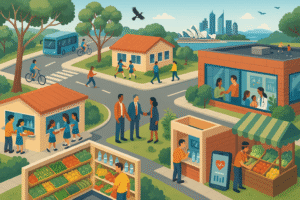Australia’s fashion scene is undergoing a thoughtful reset. Driven by climate awareness, cost‑of‑living pressures, and a rising preference for quality over quantity, more shoppers are asking where garments come from and where they end up. The result is a vibrant ecosystem that blends local craftsmanship, circular business models, and stricter scrutiny of environmental claims.
A defining feature is material choice. Brands are shifting toward certified organic cotton, hemp, linen, and responsibly sourced wool, alongside low‑impact cellulosics like TENCEL Lyocell. For synthetics, recycled nylon and polyester have gained traction, particularly for activewear suited to Australia’s outdoor culture. Designers are also experimenting with natural or low‑toxicity dye houses and water‑saving finishes to cut chemical loads.
Traceability is another cornerstone. Labels increasingly publish supplier lists, map tier‑2 and tier‑3 facilities, and share life‑cycle impact snapshots. Ethical Clothing Australia (ECA) accreditation helps verify fair and legal on‑shore manufacturing. Certifications such as GOTS (for organic textiles), OEKO‑TEX (for chemical safety), RWS (for wool), FSC/CanopyStyle (for viscose), and B Corp (for overall governance) are becoming familiar signals on product pages.
A cluster of Australian names has helped mainstream the conversation. Citizen Wolf popularised made‑to‑order tees to cut overproduction; A.BCH has championed circular design and fiber transparency; Outland Denim built a model around living‑wage employment and meticulous traceability; Bassike, Arnsdorf, and KitX have each explored lower‑impact materials and more accountable production. Marketplaces such as THE ICONIC have added robust filters to highlight lower‑impact attributes and integrations with circular platforms that enable resale or rental.
Circularity is mushrooming. Rental platforms suit wedding‑guest dressing and eventwear, while peer‑to‑peer marketplaces encourage longer product life. Local textile recovery operators collect unwanted garments, and some brands offer take‑back schemes. Community mending nights, alterations studios, and cobblers keep wardrobes in circulation, supported by a growing Repair Café movement.
Policy is nudging change. Large companies must report modern slavery risks, which has pulled supply‑chain mapping into the mainstream. Product stewardship initiatives are addressing textile waste at a national level, setting the groundwork for design‑for‑disassembly, standardized fiber labels, and scaled recycling infrastructure.
Consumers are adapting daily habits too. Cold washes, microfibre‑catching laundry bags or filters, and line drying (easy in much of Australia) meaningfully trim a garment’s lifetime footprint. Choosing durable seams, repairable silhouettes, and timeless cuts suits a lifestyle that moves between beach, office, and bush.
The energy is collaborative: designers, recyclers, policy makers, and communities are coordinating around the same goal—fewer, better garments with documented impacts. While challenges remain—traceability beyond tier‑1, chemical management in dyeing, and true end‑of‑life solutions—the momentum is unmistakable. Australia’s sustainable fashion moment looks less like a trend and more like a structural shift toward accountability and resilience.








